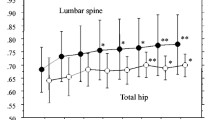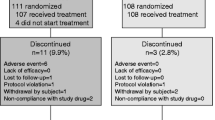Abstract:
To evaluate the efficacy and safety of alendronate, a double-masked, active (alfacalcidol) controlled comparative study for 48 weeks was carried out in a total of 210 Japanese patients with osteoporosis. The doses of alendronate and alfacalcidol were 5 mg/day and 1 μg/day, respectively. The lumbar bone mineral density (LBMD) values observed at 12, 24, 36 and 48 weeks after the initiation of alendronate treatment were 3.53 ± 0.53%, 5.37 ± 0.62%, 5.87 ± 0.74% and 6.21 ± 0.59% (mean ± SE), respectively, higher than the baseline value. Corresponding values in the alfacalcidol group were 1.50 ± 0.43%, 0.69 ± 0.63%, 1.12 ± 0.60% and 1.36 ± 0.63%, respectively. There was a significant difference between the two groups at each time point (p<0.05 or p<0.001). The bone turnover markers were depressed during treatment in the alendronate group: −32.2% for alkaline phosphatase, −53.7% for N-terminal osteocalcin and −45.0% for urinary deoxypyridinoline compared with the corresponding baseline values. On the contrary, no notable changes in these parameters were observed in the alfacalcidol group. Treatment with alendronate caused a transient decrease in serum calcium concentrations associated with an increase in the serum level of intact parathyroid hormone. In contrast, treatment with alfacalcidol resulted in a tendency of these parameters to change in the opposite direction. No difference in fracture incidence between the two groups was observed. The overall safety of alendronate was comparable to that of alfacalcidol. In conclusion, although it was a relatively short-term study of 48 weeks, the results of the present study indicate that alendronate at the daily dose of 5 mg was effective in increasing LBMD and that no serious drug-related adverse events were observed in the alendronate-treated patients. Alendronate is more efficacious than alfacalcidol in increasing bone mineral density, although the mechanisms of the actions of the two drugs are apparently different.
Similar content being viewed by others
Author information
Authors and Affiliations
Consortia
Additional information
Received: 2 July 1998 / Accepted: 4 February 1999
Rights and permissions
About this article
Cite this article
Shiraki, M., Kushida, K., Fukunaga, M. et al. A Double-Masked Multicenter Comparative Study Between Alendronate and Alfacalcidol in Japanese Patients with Osteoporosis. Osteoporos Int 10, 183–192 (1999). https://doi.org/10.1007/s001980050214
Issue Date:
DOI: https://doi.org/10.1007/s001980050214




